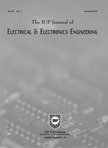
Jan'24
|
|
The IUP Journal of Electrical and Electronics Engineering
ISSN:2583-519X
A "peer-reviewed" journal included in EBSCO and ProQuest (Part of Clarivate) Database
It is a quarterly journal that publishes research papers relating to Circuit Analysis and Applications; Linear and Non-linear circuits and systems; Power systems and Power electronics; Control and instrumentation; Automation; Electric and electronic measurement systems; Electrical drives and Electromechanical systems; Microwaves; RF and Microwave; Lasers and electro-optics; Digital signal processing; Image processing and communication; Robotics and automation; Multimedia network, etc.
| Focus Areas | |
|---|---|
|
|
|
|
|
|
|||
| Article | Price (₹) | ||
| Three-Phase Transmission Line Fault Detection and Location Tracking Based on IoT |
100
|
||
| Efficiency Improvement at Signalized Intersections: Investigating Smart Green Time Allocation with Two LiDAR Sensors and Aimsun Microsimulation |
100
|
||
| Design and Fabrication of an Energy-Efficient Clothes Spin Dryer |
100
|
||
| Automated Chicken Feeder and Counter Using Yolov4 Algorithm |
100
|
||
Three-Phase Transmission Line Fault Detection and Location Tracking Based on IoT
The paper presents a prototype setup for detecting and tracking transmission line faults using Internet of Things (IoT) technology. This system automatically detects, analyzes and classifies the transmission line faults, while also tracking the location of fault. The setup uses a combination of ESP32, display, potential transformers, current transformers and GSM module to sense, process and transmit data. The instrument transformers accurately sense data and send to ESP32. Comparing with reference value, it analyzes fault and sends information via GSM module to a designated number and server. This prototype ensures fast processing of data and detects faults accurately in different scenarios.
Efficiency Improvement at Signalized Intersections: Investigating Smart Green Time Allocation with Two LiDAR Sensors and Aimsun Microsimulation
Efficient traffic management at signalized intersections is integral to urban infrastructure development, requiring accurate estimation of delay times to mitigate congestion and enhance overall transportation systems. The limitations of traditional methodologies have prompted the exploration of novel technologies like light detection and ranging (LiDAR) sensors. This paper investigates and compares the accuracy of delay time estimations obtained from LiDAR sensor technology with those derived from microsimulation in Aimsun. The paper critically examines the discrepancies and potential complementarity between delay times obtained from LiDAR sensor technology and those derived from microsimulation in Aimsun. The research involves an in-depth evaluation of real-time, high-resolution data collected by LiDAR sensors, assessing their accuracy in capturing the intricate movements and behavior of vehicles at signalized intersections. Simultaneously, Aimsun microsimulation delay time models are scrutinized for their ability to accurately replicate these observed delay times. The disparities identified serve as critical insights into the challenges of both methodologies, prompting the discussion on the prospects of integrating LiDAR-derived data and microsimulation calibration processes to enhance the precision and reliability of delay time estimations. The results demonstrate that LiDAR accurately calculates delay times at signalized intersections, with differences from Aimsun consistently below 6.5% on days with peak vehicle volumes.
Design and Fabrication of an Energy-Efficient Clothes Spin Dryer
The study proposes a low-energy-consuming clothes spin dryer machine. It comprises an interior heater and a dryer drum to speed up the drying process. The efficiency of the proposed clothes dryer was tested to determine its effectiveness. The conventional clothes spin dryer has power consumption issues due to operating voltage of 380 V AC, operating current rating of 3.12 amp, and maximum power rating of 700 W as a result of the absence of a power factor corrector. Hence, in the proposed design, a simple heating element has been used, together with an attachment of 12 VDC blower with reduced electric outputs. As a result of the added power factor corrector, the proposed machine was able to obtain an operating voltage of 220 VAC, operating current rating of 2.27 amp, and maximum power rating of 1000 W, ensuring quicker drying and less energy consumption.
Automated Chicken Feeder and Counter Using Yolov4 Algorithm
Chicken poultry business is becoming a crucial sector for sustainable food supply in the Philippines. To increase the health of chicken in coops and thus the output of chicken meat and eggs, several innovations and inventions have been made. The creation of an automated chicken feeding device might therefore be highly beneficial for the expansion of the poultry sector. This equipment may take the role of a worker in the chicken feeding process, introducing a semiautomatic procedure and thus solving the industry's labor shortage problem. The main processor of the automated chicken feeding system is a Raspberry Pi 3 Model B+. The machine consists of five main components: a Raspberry Pi with an amplifier that makes noise to draw the attention of free-range chicken; a Raspberry Pi with a pi camera that counts and detects the chickens; a Raspberry Pi with a servomotor that moves the food from storage to a container; a Raspberry Pi with a load cell that controls the number of feed to avoid food waste; and a Raspberry Pi with a temperature sensor that monitors the freshness of food. This enhances the coop's atmosphere while lowering labor costs, conserving food, and ensuring that the chicken are fed on time.